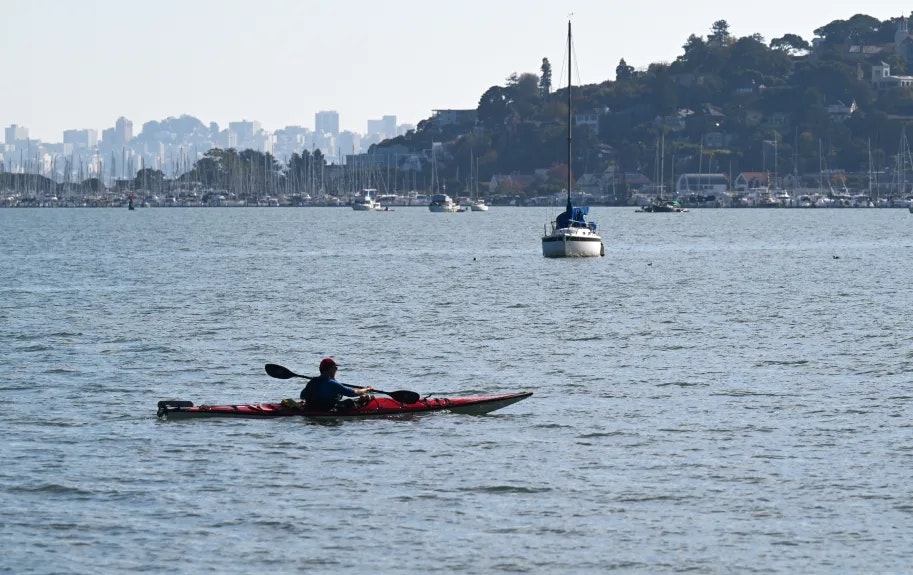Editorial: Anchor-outs must Abide by Richardson Bay Rules

A kayaker paddles across Richardson Bay near Tiburon on Tuesday, Nov. 28, 2023. (Alan Dep/Marin Independent Journal)
January 8, 2024 at 10:30 a.m.
The dwindling number of anchor-outs living on Richardson Bay are running out of reasons why they should be allowed to ignore the bay’s anchorage rules.
For too many years, they have flaunted the Richardson’s Bay Regional Agency’s 72-hour limit. Many have been there for 72 days, if not 72 months.
Anchor-outs and their supporters have argued that their lifestyle is consistent with the bay’s maritime history. They have also argued that due to the high cost of housing in our county, they have no place else to live.
Those arguments have collided with the priority of restoring and protecting the bay’s environmental quality.
Not so long ago, when more than 200 boats were anchored in the shallow bay, there was also concern about criminal activity and violence.
Following a state audit that faulted the San Francisco Bay and Conservation District Commission and RBRA for bureaucratic inaction, both agencies have reached agreement to clear the bay of the illegally anchored boats.
RBRA, marshaling state funding, has even offered a boat buyback initiative that, together with enforcement, has reduced the number of boats to 40.
That is significant progress.
Some anchor-outs are still fighting enforcement.
They were dealt a legal setback with the federal judge’s ruling upholding RBRA’s legal authority to police the bay.
Judge William Orrick III ruled that the claim made in the lawsuit filed by an anchor-out lacked an understanding of the law. The Constitution does not entitle someone “to anchor where he chooses,” he wrote.
That’s pretty clear.
The dramatic rise in anchor-outs five to 10 years ago, was partly the result of other bay communities complying with BCDC orders to enforce anchorage time limits.
Many of those displaced boat owners sailed into Richardson Bay, when at the same time, the recession led many more in a search for affordable housing to move onto boats.
Many boats were just abandoned.
Their numbers rose to about 240 boats, overwhelming RBRAs enforcement.
Their numbers have been blamed for damaging beds of eelgrass, an essential part of the bay’s ecology.
RBRA was formed in the 1980s as a regional authority to enforce the anchorage and protect the bay. Its rule was simple, but poorly enforced. If you wanted to anchor in the bay, you had only 72 hours. Otherwise, you either moved your boat out of the bay or into a berth in one of the bay’s marinas.
A regional approach made more sense for the county and four cities – Sausalito, Mill Valley, Belvedere and Tiburon – that had legal jurisdiction over their parts of the bay.
But RBRA’s ineffectiveness in dealing with the rapid rise in anchor-outs led Sausalito in 2017 to drop out and handle its own enforcement.
New leadership at RBRA led to increased enforcement, initially targeting abandoned and unseaworthy boats or those that lacked state vehicle licenses.
Judge Orrick’s ruling essentially restates RBRA’s legal authority.
The agency faces a state deadline of 2026 to enforce the bay’s anchorage limits and bring it into full compliance.
In 2021, Marin Supervisor Stephanie Moulton-Peters, who represents the county on RBRA, framed the challenge well.
“The choices for those living on the water is to depart and go to another anchorage; to create a seaworthy vessel and get it into a marina slip, and we will help you with that; or to seek housing on land, and we will help you with that as well.”
The buyback program in which RBRA has bought anchor-outs’ boats in order to help them find housing on land has been part of that commitment.
RBRA has worked hard to keep that promise and Judge Orrick’s ruling brings greater clarity to resistant boaters’ options.
